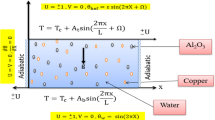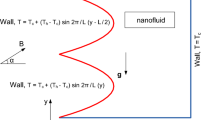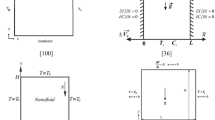Abstract
A numerical investigation of laminar mixed convection heat transfer in a lid-driven cavity filled with nanofluid under the influence of a magnetic field is executed. The left and right vertical walls of the cavity are insulated while the top and bottom horizontal walls are kept constant but different temperatures. The top wall is moving on its own plane at a constant speed while other walls are fixed. A uniform magnetic field is applied in the vertical direction normal to the moving wall. The governing differential equations are discretised by the control volume approach and the coupling between velocity and pressure is solved using the SIMPLE algorithm. The heat and mass transfer mechanisms and the flow characteristics inside the cavity depended strongly on the strength of the magnetic field. A comparison is also presented between the results obtained from the Maxwell and modified Maxwell models. The results show that the heat transfer is generally higher based on the modified Maxwell model.
Similar content being viewed by others
References
H. F. Oztop and I. Dagtekin, Mixed convection in two-sided lid-driven differentially heated square cavity, Int. J. Heat Mass Transfer, 47 (2004) 1761–1769.
M. A. R. Sharif, Laminar mixed convection in shallow inclined driven cavities with hot moving lid on top and cooled from bottom, Appl. Ther. Eng., 27 (2007) 1036–1042.
Q. Wan and A.V. Kuznetsov, Investigation of the acoustic streaming in a rectangular cavity induced by the vibration of its lid, Int. Commu. Heat Mass Transfer, 31 (2004) 467–476.
H. Masuda, A. Ebata, K. Teramae and N. Hishinuma, Alteration of thermal conductivity and viscosity of liquid by dispersing ultra-fine particles (dispersion of Al2O3,SiO2 and TiO2 ultra-fine particles), NetsuBussei (in Japanese), 7(4) (1993) 227–233.
S. U. S. Choi, Enhancing thermal conductivity of fluids with nanoparticles, in: Proceedings of the 1995 ASME International Mechanical Engineering Congress and Exposition, ASME, New York (1995) 99–105.
J. C. Maxwell, A treatise on electricity and magnetism, second ed., Oxford University Press, Cambridge (1904) 435–441.
K. Khanafer, K. Vafai and M. Lightstone, Buoyancy-driven heat transfer enhancement in a two-dimensional enclosure utilizing nanofluids, Int. J. Heat and Mass Transfer, 46 (2003) 3639–3653.
R. K. Tiwari and M. K. Das, Heat transfer augmentation in a two-sided lid-driven differentially heated square cavity utilizing nanofluids, Int. J. Heat and Mass Transfer, 50 (2007) 2002–2018.
B. Ghasemi, S. M. Aminossadati and A. Raisi, Magnetic field effect on natural convection in a nanofluid-filled square enclosure, Int. J. Thermal Sci., 50 (2011) 1748–1756.
A. G. A. Nnanna, Experimental model of temperature-driven nanofluid, J. Heat Transfer, 129 (2007) 697–704.
H. F. Oztop and E. Abu-Nada, Numerical study of natural convection in partially heated rectangular enclosures filled with nanofluids, Int. J. Heat Fluid Flow, 29 (2008) 1326–1336.
S. M. Aminossadati and B. Ghasemi, Natural convection of water-CuO nanofluid in a cavity with two pairs of heat source-sink, International Communications in Heat Mass Transfer, 38 (2011) 672–678.
M. Muthtamilselvan, P. Kandaswamy and J. Lee, Heat transfer enhancement of copper-water nanofluids in a liddriven cavity, Commu. Nonl. Sci. Numerical Simulation, 15 (2010) 1501–1510.
A. K. Santra, S. Sen and N. Chakraborty, Study of heat transfer characteristics of copper-water nanofluid in a differentially heated square cavity with different viscosity models, J. Enhanced Heat Transfer, 15 (2008) 273–287.
W. Yu and S. U. S. Choi, The role of interfacial layer in the enhanced thermal conductivity of nanofluids: a renovated Maxwell model, J. Nanoparticle Research, 5 (2003) 167–171.
D. H. Kumar, H. E. Patel, V. R. R. Kumar, T. Sundararajan, T. Pradeep and S. K. Das, Model for conduction in nanofluids, Phy. Review Letters, 93 (2004) 144301-1–4.
R. Prasher, P. Bhattacharya and P. E. Phelan, Brownianmotion-based convective conductive model for effective thermal conductivity of nanofluid, J. Heat Transfer, 128 (2006) 588–595.
J. Koo and C. Kleinstreuer, A new thermal conductivity model for nanofluids, J. Nanopartilce Res. 6 (2004) 577–588.
R. Prasher, P. Bhattacharya and P. E. Phelan, Thermal conductivity of nanoscale colloidal solutions (nanofluids), Physical Review Letters, 94 (2005) 1–4.
D. A. Nield and A. V. Kuznetsov, The Cheng-Minkowycz problem for the double-diffusive natural convective boundary layer flow in a porous medium saturated by a nanofluid, Int. J. Heat Mass Transfer, 54 (2011) 374–378.
A. V. Kuznetsov and D. A. Nield, Double-diffusive natural convective boundary-layer flow of a nanofluid past a vertical plate, Int. J. Ther. Sciences, 50 (2011) 712–717.
S. V. Patankar, Numerical heat transfer and fluid flow, Hemisphere, Washington, DC (1980).
T. Hayase, J. A. C. Humphrey and R. Grief, A consistently formulated QUICK scheme for fast and stable convergence using finite-volume iterative procedures, J. Comput. Phy., 98 (1992) 108–118.
A. J. Chamkha, Hydromagnetic combined convection flow in a vertical lid-driven cavity with internal heat generation or absorption, Numer. Heat Transfer Part A, 41 (2002) 529–546.
Author information
Authors and Affiliations
Corresponding author
Additional information
Recommended by Associate Editor Gihun Son
M. Muthtamilselvan received his Ph.D. in 2008 from the Department of Mathematics, Bharathiar University, India. He is currently an assistant professor at the Department of Applied Mathematics, Bharathiar University. His research interests are Computational Fluid Dynamics, Convection of nanofluids, Boundary layer theory.
Deog Hee Doh received the B.S. and M.S. degrees in the Department of Marine Engineering from Korea Maritime University (KMU) in 1985 and 1988, respectively. He then received the Ph.D. degree from Tokyo Univeristy, Japan, in 1995. He is currently a professor in the Division of Mech. and Energy Systems Engineering, KMU. His main research areas are Flow Visualizations, and Marine and Offshore Machinery.
Rights and permissions
About this article
Cite this article
Muthtamilselvan, M., Doh, DH. Magnetic field effect on mixed convection in a lid-driven square cavity filled with nanofluids. J Mech Sci Technol 28, 137–143 (2014). https://doi.org/10.1007/s12206-013-0953-6
Received:
Revised:
Accepted:
Published:
Issue Date:
DOI: https://doi.org/10.1007/s12206-013-0953-6




